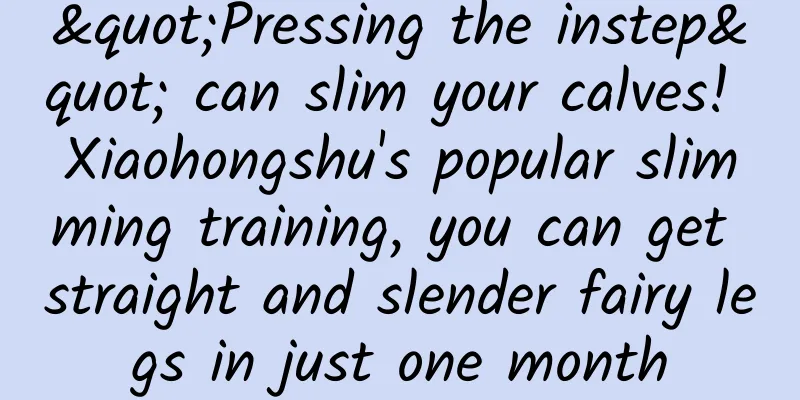"Pressing the instep" can slim your calves! Xiaohongshu's popular slimming training, you can get straight and slender fairy legs in just one month

|
If you want a pair of straight and slender fairy calves, you might as well try the "instep pressing" training that has become popular on Xiaohongshu. By exercising the instep of the foot to improve the calf lines, you can successfully slim down your calves in just one month. Want to slim down your calves? Then you must try the "instep pressing training" that has become popular on Xiaohongshu. It can not only help you improve calf valgus, but also make the calf lines straighter, so that you can have a pair of fairy-like legs in just one month. The following is an introductory guide to [Instep Pressing] shared by Xiaohongshu blogger Jiezhi Jenny, which will tell you the principle, how to do it, and common Q&A all at once. Why can pressing the instep make your calves thinner? Pressing the instep is actually to train the arch of the foot. Many people have thick calves or outward-turned legs, which is often because the arch of the foot does not apply force correctly, resulting in incorrect walking posture and making the leg muscles stronger and stronger. Through pressing the instep training, you can find the correct arch force point, and then adjust your walking posture to make your calf muscles slender and straight. Key points of instep pressing training Keep your feet together, with your heels together and your knees aligned. If your ability allows, maintain each action for at least 30 seconds Keep your core tight, sink your center of gravity, and sit firmly on your heels. Each movement takes 2-3 minutes. You should practice it every day. It takes about 10 minutes to complete the four movements. 4 basic instep pressing movements Action 1: Kneel down and sit with your insteps/heels together, with the insteps touching the ground Action 2: Kneeling, heels/toes hooked back 90 degrees, heels together Action 3: Kneeling position sitting on the metatarsophalangeal joint/pressing on the metatarsophalangeal joint instead of the toe joint Action 4: Kneeling knee lift / Use a chair or wall to complete, use your toes to support your body and lift your knees, then lower them Top 10 FAQs about Instep Pressing Q1: What should I do if I can’t sit down? It is normal for some people to not be able to sit down. It is okay. Posture correction is not comfortable at all. It will be very painful when you first sit down. You can start with 10 seconds, then slowly increase the seconds, and then you can hold on for more than 30 seconds. Q2: Can’t bring your heels together? You can take a yoga block and place it on your heels before sitting down. The yoga brick can have a good fixing effect and will make it easier when sitting. You can also use a long towel or elastic band instead, tie the elastic band around your ankles and tie a knot below your hips. Then wait until you are used to it before using the tool. If the above method still doesn't work, at least make sure your heels and knees are facing the same direction. Q3: Is there any simple alternative action? If your feet are too weak, use a plantar fascia ball to relax the soles of your feet, or grab a towel with your toes to train your foot strength. Q4: Will the rebound occur if I stop practicing? Yes, as long as you don’t do it, the problem of calf valgus will still occur. Posture is something that needs to be taken care of every minute of life. There is no one-time solution to posture correction. You can only work hard on self-discipline. Q5: Asymmetry between the left and right sides? Our bones are not completely symmetrical on both sides, so it is normal to have some deviations in practice. Q6: Do your toes/feet get cramps when doing this? Cramps may be caused by gripping the ground too hard or with too much intensity. You can reduce the intensity or time. Q7: The bones between my feet are pressed against each other and they can’t be completely closed together? What to do if you have hallux valgus? Everyone's bone condition is different, so just do the best you can without pursuing complete closure. All training must follow the four words "do your best"! Q8: Do you experience varying degrees of pain on the big toes of both feet? If it doesn't hurt too much, you can continue, or reduce the intensity. Beginners should not try too hard at the beginning. Q9: Can I have sex during my period? OK! Because this movement will not squeeze the abdomen. Q10: Do I need to rest after a few days of pain? It is normal to experience muscle soreness after doing this exercise for a few days. ※ BY JASMINE LEE AND ANN PENG ※This article is authorized by VOGUE magazine and is prohibited from being reproduced without permission. (For the full article, please visit VOGUE.com) "If you stop eating these two things, you will immediately feel your back and belly become thinner!" Vivian Hsu openly shares new tricks for maintaining curves. Do these ten things diligently! Xiao Qiang has developed an ageless beauty and figure. My hair keeps falling out and my white hair keeps growing! Nutritionists teach you how to remedy different hair problems by eating this way. Are you worried and unable to express your pain? Have you tried online counseling? For more exciting reports, please visit VOGUE website ※This article is authorized by VOGUE magazine and is prohibited from being reproduced without permission. |
Recommend
What are the dietary treatments for irregular menstruation?
Irregular menstruation is a common disease for mo...
Don't give ovarian cysts a chance!
Ovarian cysts are a type of ovarian tumor in a br...
What to eat to nourish your body after miscarriage
After miscarriage, you need to use diet to help y...
What are the causes of uterine fibroids? What should I do if I have uterine fibroids?
There are many causes of uterine fibroids. At pre...
Fasting weight loss dish taro seafood porridge to increase satiety
"Taro seafood porridge" is one of the s...
My period has been delayed for more than a month and my endometrium is thin. How long should I take Dingkundan?
My period has been delayed for more than a month ...
We should pay attention to common post-abortion precautions as soon as possible
Abortion is a common surgery that can help women ...
What is subserosal uterine fibroids? What are the hazards of subserosal uterine fibroids?
I believe everyone knows about uterine fibroids, ...
Is there any difference between surgical abortion and painless abortion? How much does it cost?
Medical technology is becoming more and more adva...
What care should menopausal patients pay attention to?
When women reach menopause, they often suffer fro...
How much does it cost to treat bacterial vaginosis in women?
Bacterial vaginosis is a disease that bothers wom...
Should your knees not go beyond your toes when squatting? Chiropractor Dr. Zhang Xuanbin reveals: 3 principles of correct squatting
The benefits of "squats" include streng...
Analysis: The main causes of adnexitis
What are the main causes of adnexitis? Adnexitis ...
How to treat chronic cervicitis with condylomata-like changes? It is recommended to treat chronic cervicitis in this way
The harm of cervicitis to women cannot be underes...
How to prevent senile vaginitis?
We know that there are many types of vaginitis, a...









